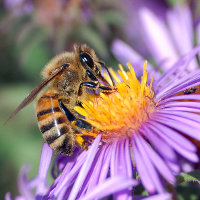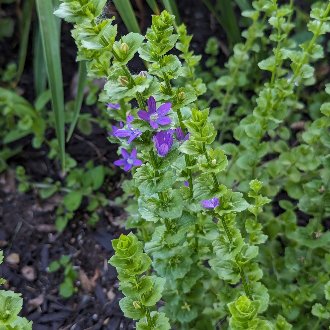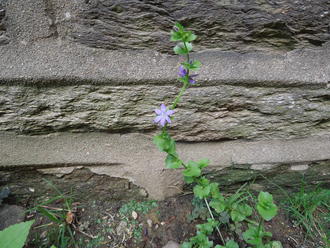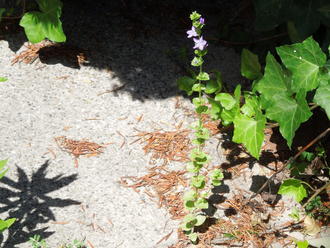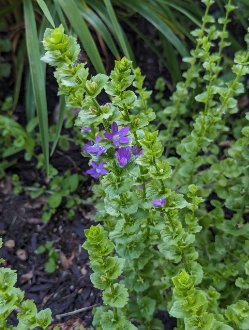Clasping Venus' Looking-glass (Triodanis perfoliata (L.) Nieuwl.)
Also classified as Specularia perfoliata (L.) A.DC.
↑Summary
An annual native to North and South America; introduced onto several other continents. One of many small, inconspicuous plants that usually go unnoticed except when people see its colorful flowers.
The common name references two things: the fact that the leaves clasp the stem at the base, and the resemblance to the European species "Venus' Looking-glass" Legousia speculum-veneris, which is named for its conspicuously shiny seeds, a characteristic not as noticeable on this species.
↑Range - Expand
| Legend | Color |
| Native | |
| Native or Not Present |
This tentative map is based on our own research. It may have limited data on Canada and/or Mexico, and there is some subjectivity in our assignment of plants as introduced vs. expanded. Read more in this blog post.
Although this plant occurs somewhere in each of these regions, it may only occur in a small part of some or all of them.
↑Habitat
Clasping Venus' looking glass is found on open ground on sunny, sparsely-vegetated sites. Natural habitats include prairies or grasslands, usually on sandy or gravely soils. Especially in the forested east, it is often more common in anthropogenic habitats, including roadsides, railroad tracks, vacant lots, cracks in cement, and sunny areas up against buildings.
It prefers full sunlight but can tolerate partial sun in otherwise exposed conditions. It prefers sandy, rocky, or gravely soil, but can occur in other soil types as well, including clay. It can be found both in more stable plant communities on soils of low fertility and with relatively little organic matter, as well as on disturbed sites on sites with more fertile soil.
Humans have created a lot of habitat for this species, but it is erratic and not usually abundant.
↑Life Cycle
This species is an obligate spring annual that typically completes its entire lifecycle during spring, extending slightly into early summer in the north of the range. The bloom time varies between being both longer and earlier (March through April) in the south of the range, and being both narrower and later (June into early July) in the north of the range. Unlike some annuals that exhibit a degree of flexibility and opportunistic germination and/or flowering, this species almost never germinates in fall or survives into summer. Rarely, especially in the south of its range, it will germinate in winter and behave as a winter annual.
Plants typically grow straight upright and are unbranched. The lower stem grows self-pollinated flowers that never open, whereas the upper stem grows open flowers for cross-pollination. One or a few flowers open at once, typically remaining open only for one day. Although the stems usually remain upright and support their own weight, they can sometimes fall over, sprawl, or get trampled, at which point the growing point of the stem typically starts growing straight up while the remainder of the stem stays fixed in whatever position it ended up in.
The seed is tiny and is dispersed by wind. Seeds exhibit a cold dormancy and do not germinate until the subsequent spring. Dormancy induction usually does not occur until April-May so it may be possible for early-germinating plants in the south of the range to complete two lifecycles, but in most of the range only one lifecycle per growing season is possible.
We could not find information on whether or not this species persists in the seed bank, but under some conditions the germination rates can be low, and it seems likely based on this plant's ecology and small seed size that its seeds may be able to persist at least short-term in the seed bank.
Plants usually die down by mid to late summer.
↑Faunal Associations
The flowers are visited by a number of small bees, including a specialist, the cellophane bee (Colletes brevicornis). The plant is browsed to a minor extent by mammals, but because of its small size and relatively low abundance, it is not an important food source for any of them.
↑Related Plants
This is the most common and widespread of seven Triodanis species in North America. All are native. The European plant by a similar common name, Legousia speculum-veneris is slightly more distantly related, and has become established at a few isolated sites in Pennsylvania and California.
Numerous other plants of Campanulaceae, the bellflower family, also occur in its range, including both native and introduced species.
↑Links & External Resources
• Triodanis perfoliata (Venus' Looking Glass) | Illinois Wildflowers (About This Site)
• Triodanis perfoliata (Clasping Venus' Looking-glass) | USDA PLANTS Database (About This Site)
• Triodanis perfoliata | Go Botany (About This Site)
• Triodanis perfoliata | Biota of North America Project (BONAP) (About This Site)
• Triodanis perfoliata | NatureServe Explorer (About This Site)
• Triodanis perfoliata | Missouri Plants (About This Site)
• Clasping Venus Looking-glass | Maryland Biodiversity Project (About This Site)
• Triodanis perfoliata (Clasping-leaved Venus' Looking-glass) | Minnesota Wildflowers (About This Site)
• Triodanis perfoliata (L.) Nieuwl. var. biflora (Ruiz & Pavon) Bradley (Small Venus' Looking-glass) | Digital Atlas of the Virginia Flora (About This Site)
• Triodanis perfoliata (L.) Nieuwl. var. perfoliata (Venus' Looking-glass, Common Venus' Looking-glass) | Digital Atlas of the Virginia Flora (About This Site)
• Triodanis perfoliata (L.) Nieuwl. | Plants of the World Online (POWO) (About This Site)

